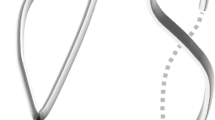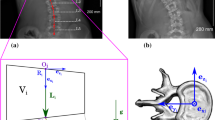Abstract
It is generally recognized that progressive adolescent idiopathic scoliosis (AIS) evolves within a self-sustaining biomechanical process involving asymmetrical growth modulation of vertebrae due to altered spinal load distribution. A biomechanical finite element model of normal thoracic and lumbar spine integrating vertebral growth was used to simulate the progression of spinal deformities over 24 months. Five pathogenesis hypotheses of AIS were represented, using an initial geometrical eccentricity (gravity line imbalance of 3 mm or 2° rotation) at the thoracic apex to trigger the self-sustaining deformation process. For each simulation, regional (thoracic Cobb angle, kyphosis) and local scoliotic descriptors (axial rotation and wedging of the thoracic apical vertebra) were evaluated at each growth cycle. The simulated AIS pathogeneses resulted in the development of different scoliotic deformities. Imbalance of 3 mm in the frontal plane, combined or not with the sagittal plane, resulted in the closest representation of typical scoliotic deformities, with the thoracic Cobb angle progressing up to 39° (26° when a sagittal offset was added). The apical vertebral rotation increased by 7° towards the convexity of the curve, while the apical wedging increased to 8.5° (7.3° with the sagittal eccentricity) and this deformity evolved towards the vertebral frontal plane. A sole eccentricity in the sagittal plane generated a non-significant frontal plane deformity. Simulations involving an initial rotational shift (2°) in the transverse plane globally produced relatively small and non-typical scoliotic deformations. Overall, the thoracic segment predominantly was sensitive to imbalances in the frontal plane, although unidirectional geometrical eccentricities in different planes produced three-dimensional deformities at the regional and vertebral levels, and their deformities did not cumulate when combined. These results support the hypothesis of a prime lesion involving the precarious balance in the frontal plane, which could concomitantly be associated with a hypokyphotic component. They also suggest that coupling mechanisms are involved in the deformation process.




Similar content being viewed by others
References
Arkin AM, Katz JF (1956) The effects of pressure on epiphyseal growth. J Bone Joint Surg Am 38:1056–1076
Aubin CE, Descrimes JL, Dansereau J, Skalli W, Lavaste F, Labelle H (1995) Geometrical modeling of the spine and the thorax for the biomechanical analysis of scoliotic deformities using the finite element method (in French). Ann Chir 49:749–761
Aubin CE, Dansereau J, De Guise JA, Labelle H (1997) Rib cage spine coupling patterns involved in brace treatment of adolescent idiopathic scoliosis. Spine 22: 629–635
Aubin CE, Dansereau J, Petit Y, Parent F, De Guise JA, Labelle H (1998) Three-dimensional measurement of wedged scoliotic vertebrae and intervetebral disks. Eur Spine J 7:59–65
Azegami H, Murachi S, Kitoh J, Ishida Y, Kawakami N, Makino M (1999) Etiology of idiopathic scoliosis. Clin Orthop 357:229–236
Burwell RG, Cole AA, Cook TA, Grivas TB, Kiel AW, et al (1992) Pathogenesis of idiopathic scoliosis: The Nottingham concept. Acta Orthop Belg [Suppl] 58:33–58
Byrd JA (1998) Current theories on the etiology of idiopathic scoliosis. Clin Orthop 229:114–119
Dansereau J, Beauchamp A, De Guise JA, Labelle H (1990) Three-dimensional reconstruction of the spine and rib cage from stereoradiographic and imaging techniques. Proc. 16th Conf Can Soc Mech Eng 2:61–64
Deacon P, Flood BM, Dickson RA (1984) Idiopathic scoliosis in three dimensions. A radiographic and morphometric analysis. J Bone Joint Surg Br 66:509–512
Deane G, Duthie B (1973) A new projectional look at articulated scoliotic spines. Acta Orthop Scand 44:351–365
Descrimes JL, Aubin CE, Skalli W, Zeller R, Dansereau J, Lavaste F (1995) Modeling of facet joints in a finite element model of the scoliotic spine and thorax: mechanical aspects (in French). Rachis 7:301–314
Dickson RA, Lawton JO, Archer IA (1984) The pathogenesis of idiopathic scoliosis. Biplanar spinal asymmetry. J Bone Joint Surg Br 66:8–15
Dimeglio A, Bonnel F (1990) Le rachis en croissance. Springer, Paris
Duval-Beaupère G (1971) Pathogenic relationship between scoliosis and growth. In: Zorab PA (ed) Scoliosis and growth. Proceedings of the third symposium on scoliosis. Churchill Livingstone, Edinburgh London, pp 58–64
Frost HM (1990) Skelatal structural adaptations to mechanical usage (SATMU). 3. The hyaline cartilage modeling problem. Anat Rec 226:423–432
Graf H, Mouilleseaux B (1990) Analyse tridimensionnelle de la scoliose. Safir, France,
Labelle H, Dansereau J, Bellefleur C, Poitras B (1996) Three-dimensional effect of the Boston brace on the thoracic spine and rib cage. Spine 21:59–64
Millner PA, Dickson RA (1996) Idiopathic scoliosis: biomechanics and biology. Eur Spine J 5:362–373
Moreland MS (1980) Morphological effects of torsion applied to growing bone. J Bone Joint Surg Br 62:230–237
Nachemson A (1964) The load on lumbar disks in different positions of the body. Clin Orthop 45:107–122
Perdriolle R, Vidal J (1987) Morphology of scoliosis: three-dimensional evolution. Orthopedics 10:909–915
Perdriolle R, Becchetti S, Vidal J, Lopez P (1993) Mechanical process and growth cartilages—Essential factors in the progression of scoliosis. Spine 18:343–349
Pope MH, Stokes IAF, Moreland M (1984) The biomechanics of scoliosis. CRC Critical Review in Biomed Eng 11:157–188
Roaf R (1966) The basic anatomy of scoliosis. J Bone Joint Surg Br 48:786–792
Schultz A, Andersson G, Ortengren R, Haderspeck K, Nachemson A (1982) Loads on the lumbar spine—validation of a biomechanical analysis by measurements of intradiscal pressures and myoelectric signals. J Bone Joint Surg Am 64:713–720
Shefelbine SJ, Carter DR (2000) Mechanical regulation of growth in the physis. Eighth Annual Symposium: Computational methods in orthopaedic biomechanics, Florida
Sommerville EW (1952) Rotational lordosis: the development of a single curve. J Bone Joint Surg Br 34:421–427
Stokes IAF, Aronsson DD (2001) Disc and vertebral wedging in patients with progressive scoliosis. J Spinal Disord 14:317–322
Stokes IAF, Laible JP (1990) Three-dimensional osseo-ligamentous model of the thorax representing initiation of scoliosis by asymmetric growth. J Biomech 23:589–595
Stokes IAF, Bigalow LC, Moreland MS (1986) Measurement of axial rotation of vertebrae in scoliosis. Spine 11:213–218
Stokes IAF, Aronsson DD, Urban JPG (1994) Biomechanical factors influencing progression of angular skeletal deformities during growth. Eur J Musculoskel Res 3:51–60
Tadano S, Kanayama M, Ukai T (1995) Computer-simulation of idiopathic scoliosis initiated by asymmetric growth force in a vertebral body. In: Third International Conference on Computer Simulations in Biomedicine, England, pp 369–376
Taylor JR (1975) Growth of human intervertebral discs and vertebral bodies. J Anat 120:49–68
Villemure I, Aubin CE, Dansereau J, Petit Y, Labelle H (1999) A correlation study between spinal curvatures and vertebral and intervertebral deformities in idiopathic scoliosis (in French). Ann Chir 53:798–807
Villemure I, Aubin CE, Grimard G, Dansereau J, Labelle H (2001) Progression of vertebral and spinal 3D deformities in adolescent idiopathic scoliosis: a longitudinal study. Spine 26:2244–2250
Villemure I, Aubin CE, Dansereau J, Labelle H (2002) Simulation of progressive deformities in adolescent idiopathic scoliosis using a biomechanical model integrating vertebral growth modulation. J Biomech Eng 124:784–790
Vital JM, Beguiristain JL, Algara C, Villas C, Lavignolle B, Grenier N, Senegas J (1989) The neurocentral vertebral cartilage: anatomy, physiology and physiopathology. Surg Radiol Anat 11:323–328
Weinstein SL (1994) The pediatric spine. Principles and practice, vol I. Raven, Philadelphia, pp 421–556
White AA (1971) Kinematics of the normal spine as related to scoliosis. J Biomech 4:405–411
Wilson-Macdonald J, Houghton GR, Bradley J, Morscher E (1990) The relationship between periosteal division and compression or distraction of the growth plate. J Bone Joint Surg Br 72:303–308
Yamazaki A, Mason DE, Caro PA (1998) Age of closure of the neurocentral cartilage in the thoracic spine. J Pediatr Orthop 18:168–172
Acknowledgements
This research project was funded by the Natural Sciences and Engineering Research Council of Canada, the Canadian Institutes of Health Research and the Foundations of Sainte-Justine Hospital and École Polytechnique. The original osseo-ligamentous finite element model was developed in collaborative association with researchers from École Polytechnique de Montréal and ENSAM-Paris. Special thanks to Mrs. Marie Beauséjour for her scientific and technical assistance in this project.
Author information
Authors and Affiliations
Corresponding author
Rights and permissions
About this article
Cite this article
Villemure, I., Aubin, C.E., Dansereau, J. et al. Biomechanical simulations of the spine deformation process in adolescent idiopathic scoliosis from different pathogenesis hypotheses. Eur Spine J 13, 83–90 (2004). https://doi.org/10.1007/s00586-003-0565-4
Received:
Revised:
Accepted:
Published:
Issue Date:
DOI: https://doi.org/10.1007/s00586-003-0565-4




